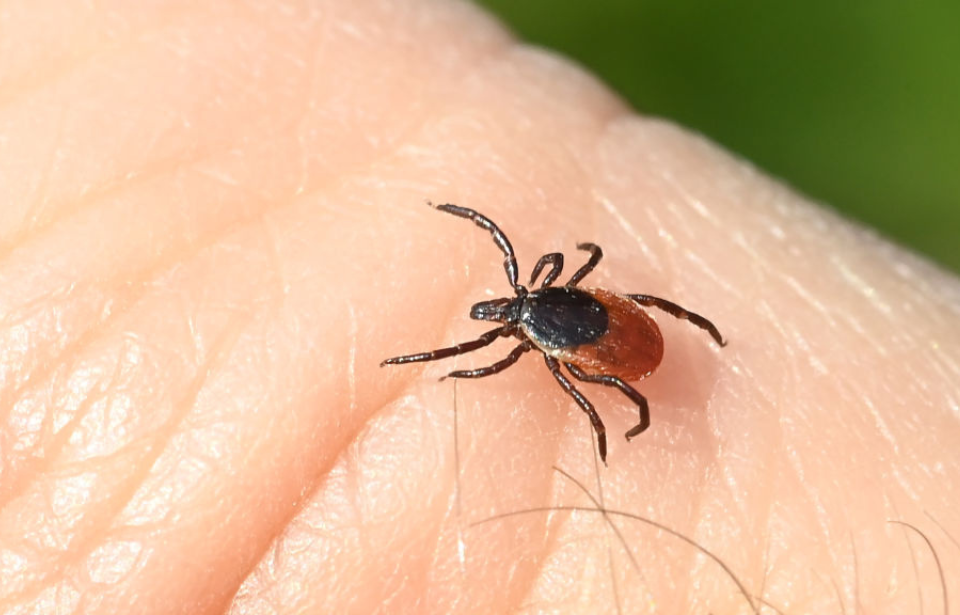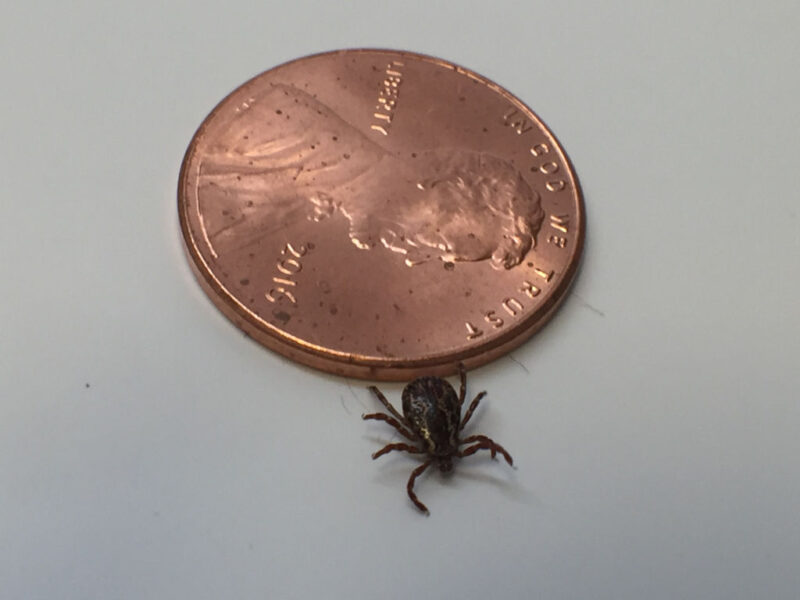Don’t Panic! Here’s What to Do If You Are Bitten By a Tick


Photo Credit: Bernd Weissbrod / Picture Alliance / Getty Images
With the upcoming summer season, outdoors-y types will be visiting campgrounds, hiking trails and woodlands across North America. While we fully advocate getting out and enjoying nature, especially when the weather’s nice, precautions need to be taken to ensure everyone remains safe. This includes taking the necessary steps to avoid tick bites, especially as the arachnids become more active. Read on to learn more!
What is a tick?


While ticks are typically referred to as “parasites,” they’re actually arachnids, meaning they’re related to spiders and scorpions. The majority of adults come in at around just under half a centimeter, and all feed upon the blood of hosts, such a wild rodents and deer. It’s through these creatures that many become exposed to the diseases that then get transmitted to humans.
There are a variety of species of ticks (40 in Canada alone), with the majority calling warmer regions home. Many have begun migrating from their original habitats, due to the movement of their hosts and increasing global temperatures making former inhospitable areas more welcoming.
Unlike other arachnids and insects, which feed upon other creatures, ticks fuel themselves with blood. They’re unable to jump, meaning they attach to hosts when the animal brushes up against tall grass or vegetation. They become active when temperatures hit at least 39 degrees Fahrenheit, and prevent exposure to colder temperatures by hiding under leaf debris on the ground.
Blacklegged tick
When you think of ticks, it’s likely the Blacklegged species comes to mind. Also known as deer ticks, they’re found across the northeastern portion of Mexico, central and eastern Canada, and in various locations across the United States, including the Midwest, southeast and East Coast. They’re identifiable by their black legs and head – hence their name.
Typically found on white-tailed deer, these ticks are active between October and May, so long as temperatures remains above freezing. Females can lay up to 1,500 and 2,000 eggs before dying, and they’re known as the primary transmitters of disease. According to the University of Rhode Island’s TickEncounter, the males do not transmit infections.
Lone Star tick
While the Blacklegged tick is the one most discussed during the summer season, the Lone Star has slowly been migrating north. Named for the white spot on the female’s back, this arachnid is found across the eastern and southeastern US and Mexico. That being said, there have also been reported sightings in Canada and even South America.
The Lone Star tick is said to travel up to three times faster than the Blacklegged species, and can be found in woodland areas. According to TickEncounter, females are most active between April and late-August, during which they can lay between 2,500 and 3,000 eggs.
Tickborne diseases
There are a number of tickborne illnesses (diseases that can be passed from ticks to humans), with the most well-known being Lyme disease. However, there are several others that are of equal concern, if not more so.
The Lone Star tick, for example, can transmit a number of bacteria, including one that causes those who’ve been bitten to become allergic to read meat. The bite can trigger Alpha-gal syndrome, which causes the body to suffer a reaction whenever red meat and other animal products, such as gelatin and cow’s milk, are ingested.
Various species of ticks can transmit Rocky Mountain spotted fever, a potentially fatal illness, while others pass Babesiosis, a Malaria-like parasite that causes flu-like symptoms. It can prove fatal to the elderly and those who are immunocompromised.
The rarest tickborne illness is probably Powassan virus. Passed by the Blacklegged and Groundhog tick, it can cause a troubling brain infection, leading to seizures and a loss of coordination.
Lyme disease
Lyme disease is a chronic disease caused by the bacterium Borrelia burgdorferi, which is spread by the Blacklegged tick. While it wasn’t necessarily a cause for concern in previous decades, the last 10-to-20 years have seen a dramatic increase in the number of cases – so much so that public health officials across North America are sounding the alarm.
Ticks aren’t born with the bacteria already in their system. They get it after feeding upon the blood of deer, birds and rodents, and can transmit it to humans after being attached for at least 24 hours. While there’s no vaccine for Lyme, most can be cured if given antibiotics within 72 hours of being bitten.
The most obvious sign of Lyme disease is a target-like rash on the body, which looks like a bullseye. Symptoms of a flu are also common when someone becomes infected, as are swollen joints, shooting pain or tingling in the feet or hands, dizziness, heart palpitations, difficulty focusing and facial palsy.
Treatments vary when it comes to Lyme disease, with the majority consisting of a course of oral antibiotics across two-to-four weeks. Those who experience long-term effects have to settle for symptom management. That being said, they should remain hopeful, as medical experts continue to study the disease and learn more about it.
Preventative measures
The best way to face the possibility of a tick bite is to lessen the chance of the arachnid attaching to you. The most obvious preventative measure is to avoid areas with tall grass or vegetation, but that’s not always possible, especially if you enjoy the wilderness. That’s why we’ve gathered a few more tips that’ll keep you safe, while also allowing you to spend time outdoors.
- Apply tick and bug repellent – This might seem obvious, but many forget to apply bug spray!
- Wear light-colored clothing – While this won’t prevent ticks from climbing up your body, it does make them easier to spot, so you can remove them before they attach.
- Tuck your pant legs into your socks and shoes – This closes off the easier access points to your body.
- Stick to designated paths, when possible – Ticks can’t jump (they become attached when you rub up against where they’re sitting), so you likely won’t encounter one if you stick to areas where there’s no grass or the vegetation has been cut.
When you’ve returned home after a day out in the wilderness, it’s important you do a check of areas where ticks most commonly like to hide, such as your hairline, groin, armpits, behind the ears, shoulders and legs. It’s also suggested that you take a shower, so any ticks that haven’t yet attached themselves fall off with the water.
You’ve been bitten by a tick – What do you do?
The most important thing to know when you’ve been bitten by a tick is not to panic. Just because the arachnid has decided you’d make a tasty snack doesn’t automatically mean it’s transmitted bacteria into your blood stream. That being said, removing ticks as soon as possible is key to preventing infection. For example, Blacklegged ticks need to be attached for at least 24 hours in order to transmit the bacteria that leads to Lyme disease.
When you find a tick attached to your body, grab a pair of clean tweezers and grasp as close to its head and your skin as possible – just be sure to not squeeze or twist the arachnid, as this could prompt it to empty its stomach contents into your bloodstream. Pull it out as straight as you can, then immediately wash the area. It’s sometimes assumed you can remove a tick by burning it or using a potent chemical, but these are myths and should be avoided.
Once the tick is removed, place it in a sealed container or baggy, and make an appointment with your health care provider. Bring the arachnid with you, so it can be tested, and answer any and all questions to the best of your abilities. The more information you can give your doctor, the better they’ll be able to help you.
While it’s likely the tick won’t have transmitted disease if caught quick enough, your doctor may still prescribe you antibiotics as a preventative measure.
Don’t let ticks ruin your enjoyment of nature
Ticks are a fact a life, and they’ll become even more so as their habitat continues to increase. As such, they’re creatures we have to learn to live alongside. As long as you take precautionary measures and dedicate time to learn about the risks, you can safely enjoy the outdoors.
More from us: Drone Discovers Truth Behind Missing Woman’s Disappearance In Forest
We hope you enjoy this summer season! Whether it’s camping, going for a hike, mountain climbing or whatever other activity you partake in outside, be sure to soak up the sun and take advantage of the quality time spent with friends and family.
Recent Posts
Ten Of The Most Stunning Waterfalls On Earth
Few sites in nature inspire more awe and wonder than waterfalls. As a result, these…
Nine Terrifying Birds That Look Just Like The Dinosaurs They’re Descended From
For a large number of animals, it's clear they descended from dinosaurs - think of…
There’s a Tree in California That’s So Special, You Could Go to Jail For Visiting It
Located deep in the heart of Redwood National and State Parks (RNSP) is the world's…
10 Unique Dive Spots From All Over The World
Considering that the Earth is covered by more than 70% water there are plenty of…
Steer Clear Of The 8 Most Dangerous Airports in the World
Most major airports are tucked away far from the main thoroughfares of cities, meaning tourists…
These Underwater Photos Will Make You Want To Never Swim In the Ocean Again
Imagine swimming through the ocean, having a relaxing float in a creek or adventuring in…